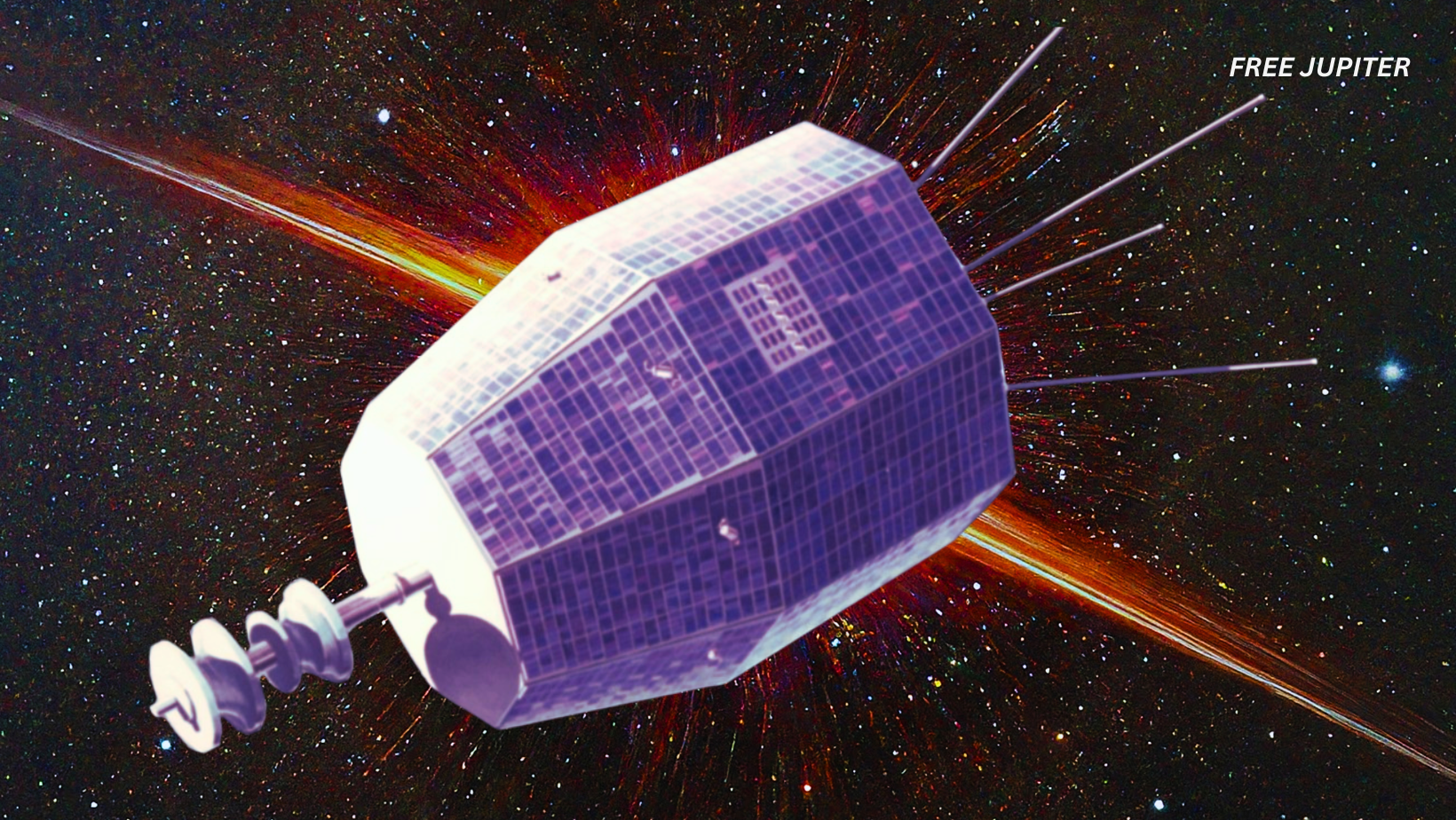Friendly Note: FreeJupiter.com shares general info for curious minds 🌟 Please fact-check all claims—and always check health matters with a professional 💙
Imagine this: a piece of old space junk, silent and forgotten for nearly six decades, suddenly screams across the sky with a flash of radio energy so powerful that it briefly drowns out everything else in the universe—at least, from a radio telescope’s point of view.
That’s exactly what astronomers think may have happened with Relay 2, a NASA satellite launched all the way back in 1964, at the height of the Cold War and space race. After going dark in 1967, it was essentially a drifting relic of early space exploration. But in June 2024, researchers in Australia picked up an intense, mysterious radio signal that appears to have come from the dead satellite itself—an unexpected cosmic “ping” that left scientists stunned and scratching their heads.
📡 The Silent Satellite That Spoke Again
Relay 2 was a part of NASA’s early experiments in space-based communications. It orbited Earth, helping relay television, telephone, and data signals—a marvel at the time. But its mission was short-lived. By 1967, its two transponders (devices that send and receive signals) had failed, and it was left to silently orbit the planet, essentially a floating tombstone to mid-century engineering.
Fast forward nearly 60 years, and this supposedly inert satellite may have just made itself heard again.
Using the Australian Square Kilometre Array Pathfinder (ASKAP), a powerful radio telescope system made up of 36 large dish antennas, scientists were scanning the sky for fast radio bursts (FRBs)—brief, bright flashes of radio energy usually coming from galaxies millions or even billions of light-years away.
Instead of a distant cosmic whisper, they caught a 30-nanosecond-long burst of astonishingly strong radio energy. That’s shorter than a single blink of an eye by several million times. It was so intense that it overpowered all other signals in the sky for that brief moment.
“We got all excited, thinking maybe we’d discovered a new pulsar or some exotic object,” said lead researcher Clancy James, from Curtin University in Australia.
🚀 Why This Signal Was So Weird
These kinds of radio bursts are not uncommon in astronomy, but their usual sources are way out there—collapsing stars, merging black holes, or super-dense neutron stars spinning like cosmic lighthouses. But this one didn’t come from deep space. In fact, it came from so close to Earth that ASKAP’s instruments couldn’t even focus on it properly.
That’s kind of like trying to take a picture of something pressed right up against your phone’s camera—it’s just too close to make out clearly.
When the scientists traced the source of the signal, all signs pointed to one extremely unlikely suspect: Relay 2.
Read more: Experts Say ‘Time Mirrors’ Are Actually A Real Thing: ‘Like Pressing Undo On The Universe’
🤯 Could a Dead Satellite Really Do That?
Short answer: yes, but not the way you think.
No one believes Relay 2 suddenly switched back on like a rebooted computer and decided to broadcast. Its systems were completely offline decades ago. Instead, scientists think something external triggered a momentary, accidental burst of radio waves.
The researchers ruled out intentional communication from the satellite. The frequency and speed of the burst didn’t match any known satellite transmissions. So, if Relay 2 was indeed responsible, it must have coughed out this signal in a much more chaotic, unplanned way.
They landed on two possible explanations—both fascinating, both completely natural.
☄️ Theory One: Hit by a Micrometeorite
Space isn’t empty. It’s littered with tiny dust-like fragments called micrometeorites. These little bits of rock and metal zip through space at tens of thousands of miles per hour. Even though they’re small—often no larger than a grain of sand—their high velocity makes them incredibly powerful.
If one of these speedy specks smacked into Relay 2, it could have caused a mini explosion of plasma (a state of matter made of charged particles), which might temporarily increase the satellite’s electrical conductivity. That sudden change could generate a radio pulse, kind of like a firecracker going off in a metal box.
In fact, it’s known that micrometeoroid impacts can directly create radio frequency emissions by themselves—just from the impact energy and particle interactions.
Read more: What Quantum Entanglement Really Reveals About the Universe
⚡ Theory Two: A Space-Static Shock
Even more likely, though, is the second theory: electrostatic discharge, or ESD.
This is essentially a static shock—but in space. Satellites constantly interact with charged particles from the sun, cosmic rays, and Earth’s magnetic field. Over time, they can build up a charge imbalance on their surfaces. If the charge becomes too great, it can suddenly discharge—like lightning between two clouds.
In this scenario, different parts of the satellite might have carried different levels of charge, and at some point, zap! The resulting discharge could briefly radiate a powerful, sharp radio wave—just like what was detected.
And since Relay 2 was built in the early days of spaceflight, it may have used materials or structures more prone to such charge buildups. Back then, shielding against ESD wasn’t as well understood or prioritized as it is today.
🛰️ Why This Matters Now
This isn’t just a fun science oddity or an episode of Ancient Aliens. Understanding events like this has real, modern applications.
According to Karen Aplin, a professor of space science at the University of Bristol, studying these surprise signals can help researchers better understand how electrostatic discharges happen in space, especially as we launch more small, low-cost satellites into orbit.
Many of today’s satellites—especially tiny ones like CubeSats—don’t have the same level of protection against space weather or ESD. If these little satellites get zapped and emit signals like Relay 2 did, scientists could potentially detect and study them remotely, using Earth-based radio telescopes.
In a world increasingly filled with space debris and countless orbiting devices, even accidental radio flashes could be used to monitor satellite health, aging, or even collisions.
🧠 Zooming Out: Ghosts in the Machine
This story isn’t just about one old satellite—it’s a reminder that space, despite its vast silence, is full of leftover echoes and potential surprises.
What makes Relay 2’s case special is how it combines history, mystery, and physics into a single, fleeting burst. It also adds to the growing conversation about how we track and deal with the enormous amount of human-made material now orbiting Earth. From functioning satellites to broken-down relics to random fragments from past missions, the skies above us are getting crowded—and noisy.
And if Relay 2 can still make itself known after all these years, it makes you wonder: how many other “dead” satellites might one day whisper back?
Related Cosmic Curiosities
If this zombie-satellite story caught your attention, here are a few other space mysteries you might enjoy:
- JWST’s Exoplanet Surprises: The James Webb Space Telescope is discovering bizarre and unexpected signals from distant planets, some with atmospheres full of steam, carbon, or even hints of water clouds.
- China’s Defunct Satellite Sparks Fireball in 2023: A different decommissioned satellite caused a stir when it reentered Earth’s atmosphere and lit up the sky.
- Ghost Signals from Voyager: NASA’s Voyager 1, launched in 1977, recently baffled scientists by sending back gibberish signals from beyond the solar system—another spooky “life after death” moment for old tech.
Read more: Astronomers Detect The Most Powerful Explosions in the Universe Since the Big Bang
Final Thought: Cosmic Comebacks
In the end, Relay 2’s brief shout across the radio spectrum is less about a machine coming back to life, and more about the universe reminding us that nothing truly disappears without a trace. Even our oldest technology leaves a mark—and sometimes, it echoes back in spectacular fashion.










